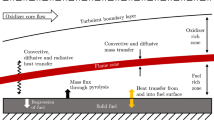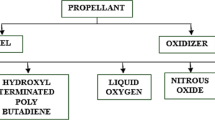Abstract
Hybrid rocket engines have gathered significant attention due to their ease of use, safety, and affordability associated with traditional chemical propulsion systems. They offer the advantage of on-demand throttle and thrust adjustments. The performance of hybrid rocket engines depends on the regression rate, which is the transition of the solid fuel grain to flammable gas. Unlike solid and liquid engines, hybrids experience varying oxidizer-to-fuel (O/F) ratios over time. Factors such as changes in oxidizer flow and fuel port diameter contribute to this fluctuation, leading to incomplete combustion and reduced efficiency. To enhance hybrid rocket engine performance, ongoing research explores various methods. One approach is increasing the oxidizer flow velocity over the burning fuel surface. This paper employs analytical and numerical techniques to determine the effective oxidizer/fuel ratio for a single-port fuel grain in a hybrid rocket engine. Ultimately, the research aims to optimize performance, allowing this secure and efficient propulsion technology to mature.














Similar content being viewed by others
Abbreviations
- P c :
-
Combustion chamber pressure in N/m2
- I sp :
-
Specific impulse in second
- C*:
-
Characteristic velocity or C-star in m/sec
- T cc :
-
Temperature in combustion chamber in Kelvin
- Wt.:
-
Weight in Newton
- GOX:
-
Gaseous oxygen (dimensionless)
- HRE:
-
Hybrid rocket engine (dimensionless)
- CEA:
-
Chemical equilibrium with applications (dimensionless)
- CFD:
-
Computational fluid dynamics (dimensionless)
- HTPB:
-
Hydroxyl-terminated poly-butadiene (dimensionless)
- O/F:
-
Oxidizer/fuel (dimensionless)
- C f :
-
Coefficient of force (dimensionless)
- \({\dot{m}}_{{\text{p}}}\) :
-
Propellant mass flow rate in kg/s
- \({D}_{{\text{ext}},{\text{g}}}\) :
-
Solid fuel grain external diameter in mm
- \({D}_{{\text{int}},{\text{g}}}\) :
-
Solid fuel grain internal diameter in mm
- \({D}_{{\text{int}},{\text{g}}}\left(0\right)\) :
-
Fuel grain initial internal diameter/port diameter in mm
- \({G}_{{\text{ox}}}(0)\) :
-
Oxidizer mass flux at the beginning in kg/m2 s
- \({L}_{{\text{g}}}\) :
-
Length of Fuel grain in mm
References
Karabeyoglu M, Cantwell B, Altman D (2001). Development and testing of paraffin-based hybrid rocket fuels. In: 37th joint propulsion conference and exhibit, p 4503
Santos LMC, Almeida LAR, Fraga AM, Veras CAG (2006) Experimental investigation of a paraffin-based hybrid rocket. Rev Eng Térm 5(1):08–12
Lee TS, Tsai HL (2008) Combustion characteristics of a paraffin-based fuel hybrid rocket. In: 9th Asia-Pacific international symposium on combustion and energy utilization, pp 2–6
Srivastava S, Ingenito A, Andriani R (2019) Numerical and experimental study of a 230 N Paraffin/N2O hybrid rocket. In: EUCASS 2019–8th European conference for aeronautics and space sciences, pp 1–13
Cantwell B, Karabeyoglu A, Altman D (2010) Recent advances in hybrid propulsion. Int J Energ Mater Chem Propuls 9(4). https://doi.org/10.1615/IntJEnergeticMaterialsChemProp.v9.i4.20
Hikone S, Maruyama S, Isiguro T, Nakagawa I (2010). Regression rate characteristics and burning mechanism of some hybrid rocket fuels. In: 46th AIAA/ASME/SAE/ASEE joint propulsion conference & exhibit, p 7030
Venugopal S, Rajesh KK, Ramanujachari V (2011) Hybrid rocket technology. Def Sci J 61(3):193
Nakagawa I, Hikone S (2011) Study on the regression rate of paraffin-based hybrid rocket fuels. J Propul Power 27(6):1276–1279
Pastrone D (2012) Approaches to low fuel regression rate in hybrid rocket engines. Int J Aerosp Eng 2012. https://doi.org/10.1155/2012/649753
Kobald M, Ciezki H, Schlechtriem S (2013) Optical investigation of the combustion process in paraffin-based hybrid rocket fuels. In: 49th AIAA/ASME/SAE/ASEE joint propulsion conference, p 3894
Kobald M, Ciezki HK, Schlechtriem S, Toson E, De Luca L (2014) Evaluation of paraffin-based fuels for hybrid rocket engines. In: 50th AIAA/ASME/SAE/ASEE joint propulsion conference, p 3646
Wongyai P, Greatrix DR (2016) Regression rate estimation for swirling-flow hybrid rocket engines. J Propul Power 32(1):18–22
Kobald M, Schmierer C, Ciezki HK, Schlechtriem S, Toson E, De Luca LT (2017) Viscosity and regression rate of liquefying hybrid rocket fuels. J Propul Power 33(5):1245–1251
Petrarolo A, Kobald M, Schlechtriem S (2017) Liquid layer combustion visualization of paraffin-based hybrid rocket fuels. In: 53rd AIAA/SAE/ASEE joint propulsion conference, p 4828
Siebel S (2017) Rheological and burning behavior of paraffin-based fuels for hybrid rocket propulsion. https://www.hdl.handle.net/10589/134038
Tian H, Li Y, Li C, Sun X (2017) Regression rate characteristics of hybrid rocket motor with helical grain. Aerosp Sci Technol 68:90–103
Petrarolo A, Kobald M, Schlechtriem S (2018) Understanding Kelvin-Helmholtz instability in paraffin-based hybrid rocket fuels. Exp Fluids 59(4):62
Leccese G, Cavallini E, Pizzarelli M (2019) State of art and current challenges of the paraffin-based hybrid rocket technology. In: AIAA propulsion and energy 2019 forum, p 4010
Quadros FD, Lacava PT (2019) Swirl injection of gaseous oxygen in a lab-scale paraffin hybrid rocket motor. J Propul Power 35(5):896–905
Liu LL, He X, Wang Y, Chen ZB, Guo Q (2020) Regression rate of paraffin-based fuels in hybrid rocket motor. Aerosp Sci Technol 107:106269
Glaser C, Hijlkema J, Anthoine J (2022) Evaluation of regression rate enhancing concepts and techniques for hybrid rocket engines. Aerotec Missili Spazio 101(3):267–292
Tyurenkova VV, Stamov LI (2019) Flame propagation in weightlessness above the burning surface of material. Acta Astronaut 159:342–348
Betelin VB, Kushnirenko AG, Smirnov NN, Nikitin VF, Tyurenkova VV, Stamov LI (2018) Numerical investigations of hybrid rocket engines. Acta Astronaut 144:363–370
Kushnirenko AG, Stamov LI, Tyurenkova VV, Smirnova MN, Mikhalchenko EV (2021) Three-dimensional numerical modeling of a rocket engine with solid fuel. Acta Astronaut 181:544–551
Smirnov NN, Betelin VB, Nikitin VF, Stamov LI, Altoukhov DI (2015) Accumulation of errors in numerical simulations of chemically reacting gas dynamics. Acta Astronaut 117:338–355
Smirnov NN, Betelin VB, Shagaliev RM, Nikitin VF, Belyakov IM, Deryuguin YN, Aksenov SV, Korchazhkin DA (2014) Hydrogen fuel rocket engines simulation using LOGOS code. Int J Hydrogen Energy 39(20):10748–10756
Tyurenkova VV, Smirnova MN (2016) Material combustion in oxidant flows: self-similar solutions. Acta Astronaut 120:129–137
Tyurenkova VV, Smirnova MN (2023) Analytical approach to flame propagation over thermally destructing structured material problem. Acta Astronaut 213:438–445
Funding
The authors have not disclosed any funding.
Author information
Authors and Affiliations
Corresponding author
Ethics declarations
Conflict of interest
The authors declare that they have no competing interests.
Rights and permissions
Springer Nature or its licensor (e.g. a society or other partner) holds exclusive rights to this article under a publishing agreement with the author(s) or other rightsholder(s); author self-archiving of the accepted manuscript version of this article is solely governed by the terms of such publishing agreement and applicable law.
About this article
Cite this article
Ommounica, C., Srivastava, S. & Haldar, S. Numerical study of the hybrid rocket engine. AS (2024). https://doi.org/10.1007/s42401-024-00280-7
Received:
Revised:
Accepted:
Published:
DOI: https://doi.org/10.1007/s42401-024-00280-7




